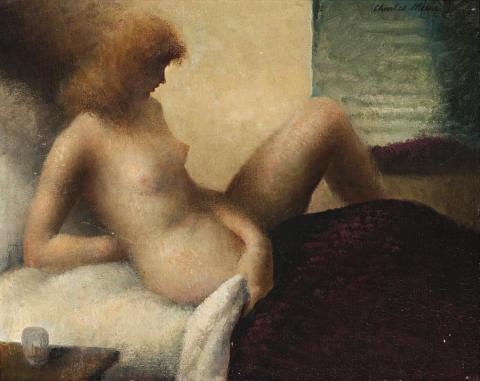FRENCH NUDE, c.1939
CHARLES MEERE
oil on canvas on board
30.5 x 38.0 cm
signed upper right: Charles Meere
inscribed verso: 18 / French / nude
Private collection, New South Wales
Private collection, Sydney
Charles Meere's mastery of the human figure is seen at its athletic best in Australian Beach Pattern, 1940, in the collection of the Art Gallery of New South Wales, Sydney, an icon of beach life and good health. While displaying his considerable creative skills in painting the female nude, French Nude, c1939 strikes a very different note of sensual intimacy. The intimacy of the soft focus is equally suggestive of the private pleasures of the flesh, the positioning of the arms conveying embrace. Yet, it has a detachment that is tantalising, enhanced as much by what is concealed as is revealed. When teaching anatomy and life drawing at the East Sydney Technical College from 1936, Meere '... advocated that both male and female models should be totally undressed'.1 This is seen in the striking realism of The Young Model, 1941 (Deutscher and Hackett, Melbourne, 20 April 2011, lot 42). Writing in 1949, his friend and fellow artist, Herbert Badham, said of Meere's art: 'He does not make actual transcripts from nature, nor does he depend on obvious emotional urges to express himself; rather does he take physical truths for his themes, reconstructing them to reveal afresh their basic form and structure.'2 While this applies to much of Meere's art, French Nude dispenses with the objectivity that characterises his art for the more personally felt - the private moment as distinct from the public presentation.
During World War I Meere served with the London Regiment. In 1919 he married Denise Moreau, whom he had met when hospitalised in France. Studying design and mural painting at the Royal College of Art, London from 1919-22, he later painted in France and furthered his studies at Colarossis, Paris. Their son Desmond was born in 1920, the family eventually settling in Dinan, Brittany, one of the most attractive walled towns in France. It inspired a number of grand landscapes as The Viaduct, France, 1924 and Dinan, 1926, shown in the 1987 exhibition of Meere's work presented by the S.H. Ervin Gallery, Sydney. Meere is also represented in the Musée du Chateau de Dinan. In 1927 Meere visited Australia, before settling here in 1933. He was awarded the Sulman Prize in 1938 and the Wynne Prize in 1951. During the forties he painted several Dinan landscapes, Dinan sur la Rance, 1941 and Au fond du viaduct à Dinan, c1944 also being included in the S.H. Ervin exhibition of 1987. French Nude, c1939 was probably painted during this period. While Meere's reflections on France were possibly aroused by German occupation during World War II, the diaphanous nature of French Nude is redolent of recollection, dreaming of what once was.
1. Harvey, E. A., quoted in Slutzkin, L., Charles Meere 1890-1961, S.H. Irvin Gallery, Sydney, 1987, p. 4
2. Badham, H., The Story of Australian Art, Currawong Publishing Co. Pty. Ltd., Sydney, 1949, p. 135
DAVID THOMAS
